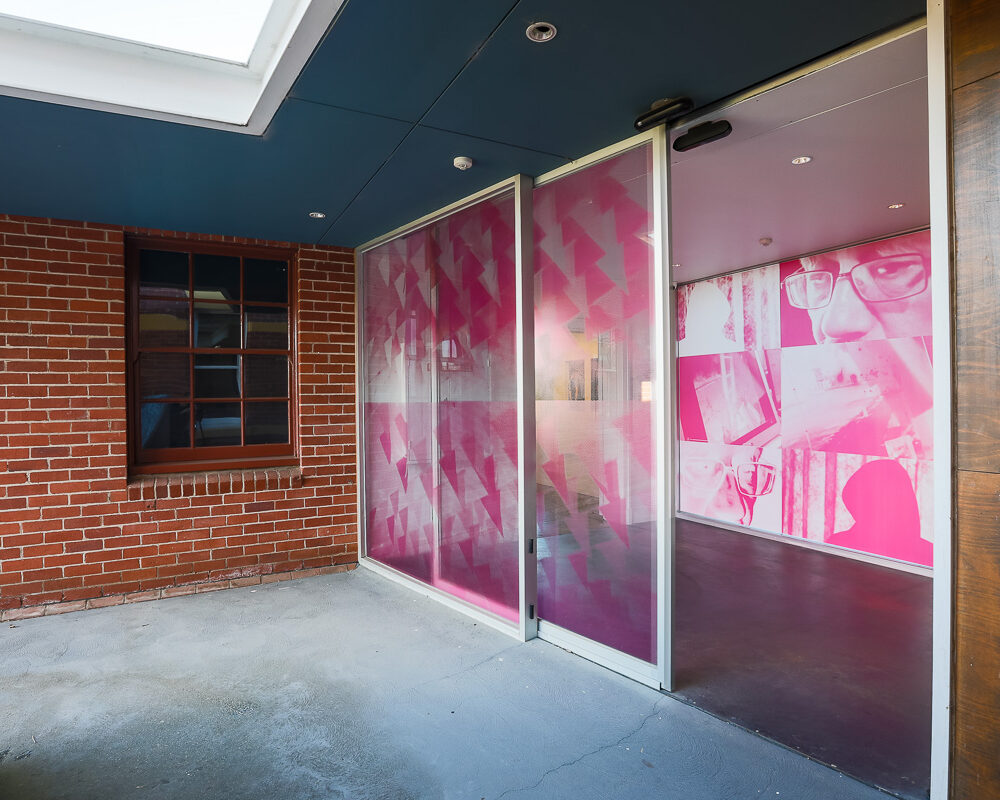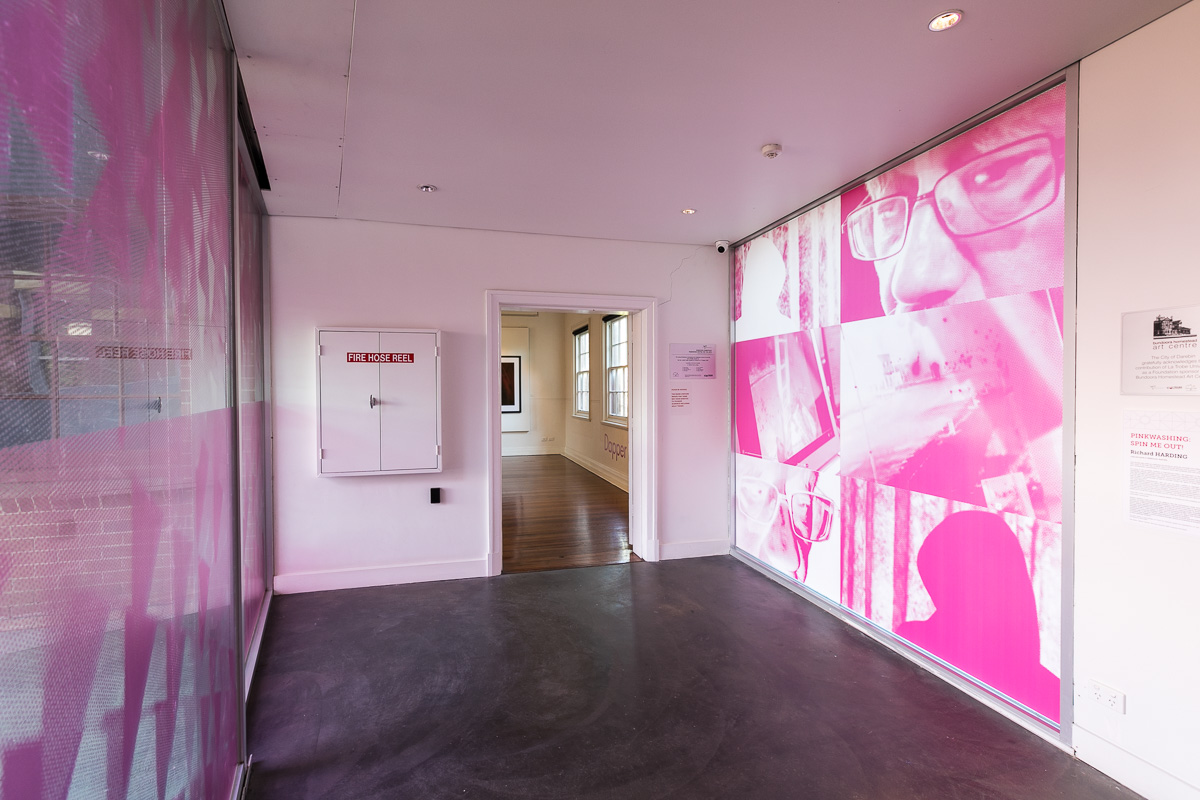
‘Pinkwashing’ at Bundoora Homestead Art Centre
Artist Richard Harding explains how Spin me Out, the latest iteration of his Pinkwashing project, connects with previous exhibitions. Pinkwashing is at Bundoora Homestead Art Centre until 3 March.
15 February, 2019
In Exhibitions,
Printmaking, Q&A
Imprint: What is the premise for the Pinkwashing project and how have you been working towards it?
Pinkwashing is an ongoing project rather than a singular exhibition. Currently there have been three iterations presented publicly. The exhibition at Bundoora Homestead Art Centre is the second iteration of the project Pinkwashing and is subtitled, Spin me Out. The first iteration was at c3 contemporary art space in April 2018 and the third was on show at the Hong Kong Open Printshop (HKOP) over January 2019 subtitled Final Rinse.
The Pinkwashing project repurposes photographic stills from an SBS Broadcast of the opening of the Veduchi Ski Resort in Chechnya over January 2018. According to Andrew Roth from the Washington Post the Veduchi opening was designed to ‘symbolize the prosperity and peace’ brought about by the Kadyrov government (Jan 2018). However, at the same time as these celebrations were taking place ‘anti-gay purges’ were being conducted. The rounding up and detaining people of difference—specifically LGBT people—to be interrogated. This resulted in torture for many and for some led to death.
My objective with this artwork has been to construct a non-linear narrative symbolising the way these targeted attacks appear to be randomly activated and reported on. Yet with deeper scrutiny they come across as well planned and systematically premeditated having a devastating outcome and effect on the LGBTIQ community.
After Pinkwashing’s first iteration at c3 contemporary art space last year I started exploring alternative substrates and materials as a means of moving the work from the shelter of the gallery to a more ‘High Vis’ presentation space. I wanted to activate the protest nature of the work in a more public space.
Note: as Melbourne’s LGBTIQA+ community again celebrates Midsumma in 2019 there are new reports that the so called ‘gay-purge’ has been reactivated in Chechnya.
Imprint: What are visitors likely to experience, in a visual sense? What are your hopes for the sorts of responses they might have to the work?
The iteration of Pinkwashing at Bundoora Homestead Art Centre, Spin me Out, utilises the entry vestibule as a multipurpose space: to enter, a space between spaces and a space to exit. The architectural positioning of the work on the front window and sliding glass door holds a key to the artworks purpose with the celebration of resilience in the face of adversity. The depiction of bunting is a universal symbol of celebration. These transparent pink images swathed the viewer with a pale pink light and they are ‘immersed’ in a rose like colour as they enter the building.
The images on the back window are also pink with white—opaque and illustrative—purposeful in their seemly generic look. They are interchangeable with each other highlighting the similarity of incidents of oppression and persecution globally.
My aim for visitors as they enter the gallery is that they feel a sense of celebration and ease of being. As they view the work and move between the spaces this feeling transforms into a deeper reading of our own privilege and vulnerability. I am attempting to activate the viewer beyond sympathy or the standard tut tutting of the compassionate.
Imprint: How was the work developed technically and what were some of the challenges involved?
Being offered the entry at Bundoora Homestead Art Centre allowed for the Pinkwashing project to reposition itself within a public art realm. It enabled the project to access an expanded idea of visibility through the symbol of windows and the materiality of glass. This presented new challenges technically so the research into vinyl adhesives and window decals began. Fortunately, one of my colleagues—Tyler Payne—assisted in this exploration. Her knowledge of the current products and methods used by the advertising industry led me to forming the new work in an acrylic substrate called Octopus® with high end industry-based printing.
Having the final works commercially printed added to the public flavour of the installation. With this the notion of advertising comes into play… not advertising for a product but an action or provocation to act. The installation proved interesting as the work needed to be positioned using window cleaner or soapy water. This information was not forth coming but once discovered the application of the decals proved surprisingly simple and quick. The use of liquid enabled a greater ability of precision that the historic vinyl adhesives could not.
Imprint: In what ways does the Pinkwashing work connect with ideas and forms from previous bodies of work you have created?
The ideas activated through Pinkwashing are a result of ongoing projects related to the LGBTIQA+ here—Australia—and globally. The artworks I have created over the past few years usually begin at a local level and they are applied to global concerns. My practice continues to address notions of the closet—in all its forms. The concepts embedded in Pinkwashing continue my interest and alignment with the American theorist, Eve Koskofsy Sedgwick’s epistemological positions of the closet along with my ongoing advocacy of ‘print as other’.
Ideas of marginalisation and protest are explored and activated in this work as they were in the 2017 installation Break in transmission presented at Trocadero Art Space. The use of reproductive technologies is instrumental in my practice as a contemporary artist. The concepts of authenticity, repetition and the multiple continue to to be interrogated through diverse medium choices. These are always used to underline my philosophical positions in identity and otherness.
–
My news media sources include: Novaya Gazeta (RU) Russian Newspaper, The Advocate (USA), The Guardian UK, BBC News (UK), SBS News (AUS), Vox (USA)





